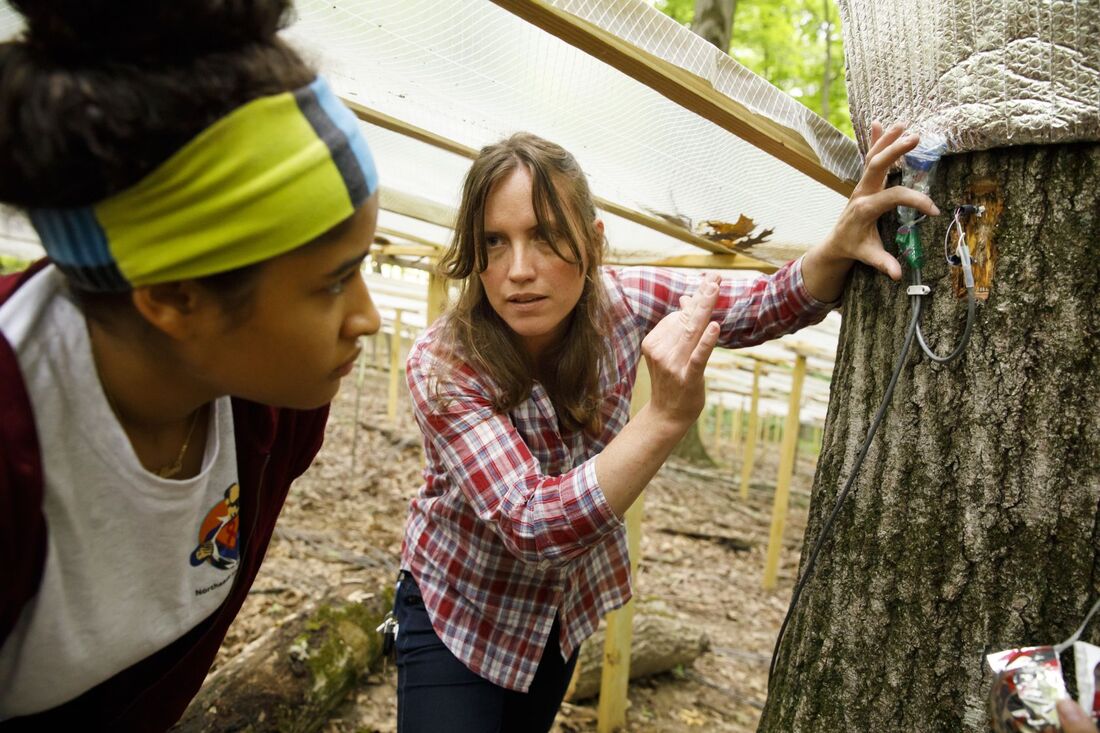In my view, ecohydrologists seek to understand the sustainability of ecosystem water, carbon and energy cycles under changing climate and land-use regimes. Like other new and blended disciplines (including biogeochemistry, ecophysiology, and biometereorology), ecohydrology merges concepts from more “classical” fields to tackle research problems that must be addressed from an interdisciplinary perspective.
What are your undergraduate and graduate degrees in?
My undergraduate degree is in Civil and Environmental Engineering, and my PhD is in environmental science. Both degrees are from Duke University – go Blue Devils!
How did you arrive at working in/thinking about ecohydrology?
When I was an undergraduate, my Water Resources Engineering class took a field trip to the Duke Face and AmeriFlux sites. I have to admit, my favorite part of the field trip was the chance to climb one of the flux towers. I thought it might be fun to do that all summer, and luckily Dr. Gaby Katul (who would eventually become my undergrad thesis and PhD advisor) had a summer research position for me.
Eventually, much of my PhD work happened on those towers in the Duke Forest. From Gaby, my lab mates (including Dr. Paul Stoy), and committee members (including Dr. Ram Oren), I learned the fundamentals of hydrology, micro-meteorology, and eco-physiology which govern most of the work my lab does today. As a PhD student, and as a post-doc as the Coweeta Hydrologic Laboratory, I spent quite a bit of time figuring out how the eddy covariance flux measurement technique works, especially in more challenging topographical settings. Now the theory of flux measurements is reasonably advanced, many new tools exist to simplify data processing and distribution, and the continued growth of networks like Fluxnet, AmeriFlux, and NEON give us thousands of sites-years of data to play with. This means we are finally poised do the really fun work of applying flux measurements to study land-atmosphere mass and energy exchanges directly at policy- and management-relevant scales.
What do you see as an important emerging area of ecohydrology?
I think the future of ecohydrology, and other related disciplines, will be much more applied. For decades, my sub-field has been strongly focused on reducing uncertainty in future predictions of land-atmosphere carbon exchange. We haven’t solved that problem yet, but through trying, we’ve gained a lot of highly useful and practical knowledge. For example, we now have a deep understanding of the tradeoffs between carbon uptake and water use at leaf- to watershed- scales. We’ve developed new frameworks for measuring and modeling ways that ecosystems can modify local energy balance and temperature. And especially over the last 5-10 years, we’ve made great strides in understanding how individual species, and their eco-physiological traits, contribute to stand- and watershed-scale dynamics. Much work remains to fully integrate these new paradigms into more certain predictions of future carbon uptake. However, we now know enough to make meaningful and useful contributions to questions about water resources and agricultural sustainability, and the development of resilient forest management strategies. Indeed, there are many examples of eco-hydrologists already engaging in this type of work; moving forward, I think we can expect an onus on us to do more of it.
Do you have a favorite ecohydrology paper? Describe/explain.
Well, technically it’s two: Penman (1948) and Monteith (1965), which together describe the Penman-Monteith equation for evapotranspiration. It’s challenging for me to think of a paper my lab has published that doesn’t rely on some variant of this equation. The model is a beautiful blend of principles from thermodynamics and aerodynamics incorporating both abiotic and biotic controls; its applications span the range from theoretical to applied. It’s simple enough to be reproduced in a single line of text and code, yet complicated enough that its predictions and dynamics can still surprise me after 15 years of working with the model.
What do you do for fun (apart from ecohydrology)?
I enjoy chasing after my three kids (ages 10, 3 and 1) in collaboration with my husband Mike. Lately I’ve gotten back into competitive running…something I did a lot of when I was younger. And while I appreciate that this question is looking for answers outside science, I have to say that I have a lot of fun with my job. Every day, I get to try to solve challenging math and science problems, working with great people all over the world; it’s a privilege I feel very lucky to have.

 RSS Feed
RSS Feed